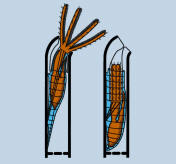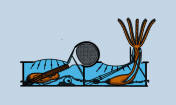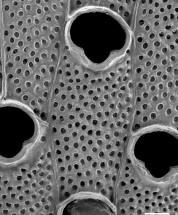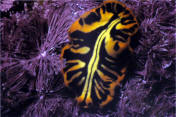|
Bryozoa (moss animals, false lace corals)
Life >
Eukaryotes
>
Opisthokonta >
Metazoa
(animals) >
Bilateria > Lophotrochozoa
Introduction
|
Bryozoans are small, often inconspicuous, sessile (living in one place) colonial
animals, which may be found in most marine habitats, with a few fresh water
species. The functional units of these animals or zooids lay next to each other
and are in contact via pore plates. Some are specialised to be feeding zooids or
Autozooids, each possesing a lophophore or crown of tentacles which capture prey
and is then digested in a true gut. Nutrients are passed down through the colony
by connective pores in the pore plates.
Bryozoans are also true hermaphrodites and alternate in releasing sperm and eggs
to avoid any one colony being fertilized by itself. Colonies are produced by
repeated budding of the zooids from one sexually produced zooid termed an
ancestrula. Each zooid within a colony is thus a functional clone of the next.
Because every ancestrula is produced sexually, every colony has its own unique
genetic identity. Furthermore depending on the pattern of budding different
types of colonies are formed. They may be encrusting or erect. The latter may be
calcified or uncalcified; delicate, bushy and plant-like or forming honeycomb
structures of fused plates.
The oft-quoted figure of 4000 known bryozoan species appears to be a gross
underestimation of the true number that exists globally, as approximately 1000
species of bryozoans were described in the second half of the twentieth century
and the rate of discovery exhibits no signs of decreasing. Bryozoans are
generally classified by the structure of their skeletons which are primarily
composed of chitin or calcium carbonate. They are divided into two classes, the
Phylactomata which occur in freshwater and the Gymnolaemata which is almost
exclusively marine. The latter is divided into three classes. The Ctenostomata
are soft bodied bryozoans that form stoloniferous networks and are mostly
freshwater. The Cyclostomata have simple tubuliferous zooids and have swellings
which brood eggs called gonozoids. The Cheilostomata have zooids that are
generally box-shaped and commonly brood larvae in ovicells. At present ~296
bryozoan species are known from South Africa.
|



|
Ecology
Bryozoans are largely predated upon by nudibranchs
and flat worms, while they use a ring of tentacles called a lophophore
to filter small prey items out of the surrounding water. As a group they
are generally protected against predators by defensive zooids called
avicularia, which have biting teeth that also prevent any organisms from
settling on the colony surface.
Bryozoans are able to form unusual interactions and associations with
other organisms. They have been observed colonising the surfaces of
seaweeds, mulluscs, turtles, sea snakes and even plastic debris that
drifts in the current systems. The gastropod, Burnupena papyracea
is easily recognisable in the field because it is covered by
Alcyonidium nodossum, which forms a striking orange or purple cloak
on its shell. Associations of this nature result in bryozoans that are
no longer sessile and thereby increase their distributions. |

 |
Bryozoa and humans
Bryozoans are important as potential indicators of
environmental health, one of the top known fouling organisms globally and a
source of biomedical compounds. Because they are sessile, bottom dwelling,
organisms, they are usually the first to be affected by pollution or stress.
Bryozoans are known to be one of the six main marine fouling organisms; the
others being barnacles, serpulid polychaete tube-worms, sea squirts, sponges and
hydroids. They generally foul marine and freshwater industrial intake pipes, oil
rigs, bouys, moorings, hulls of sea-going vessels and even drift plastics thrown
away at sea. Increased drag caused by fouling organisms growing on the hulls of
ships results in lost revenue for the shipping industry and is the primary
reason why antifouling paints have been developed. Bryostatin, a compound
isolated from the bacterial symbiont associated with Bugula neritina, is
under investigation as anti-cancer and memory enhancement drugs. Clinical trials
have suggested that this group of drugs could potentially be used to treat
leukaemia and tumour cells as well as enhancing memory in Alzheimer's patients.
Classification of the Recent South African Bryozoa
Stenolaemata |
|
| |
Order: Cyclostomata
|
|
Gymnolaemata |
|
| |
Order: Ctenostomata
|
|
| |
Order Cheilostomata
|
|
|
